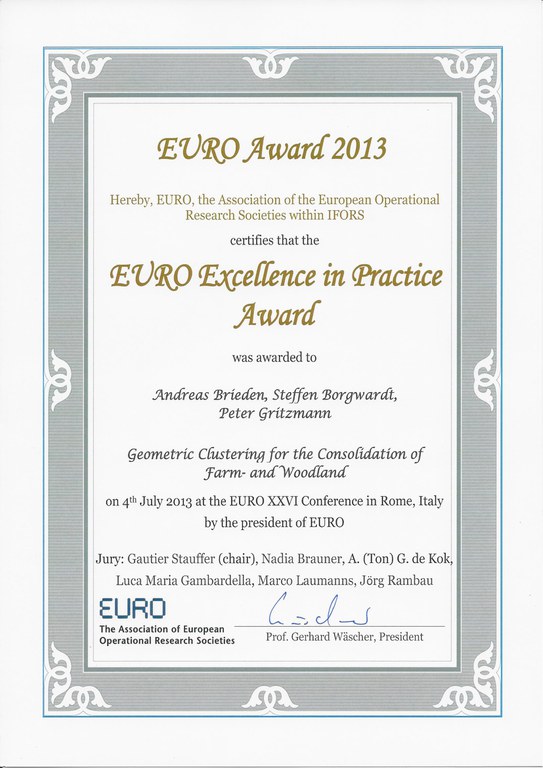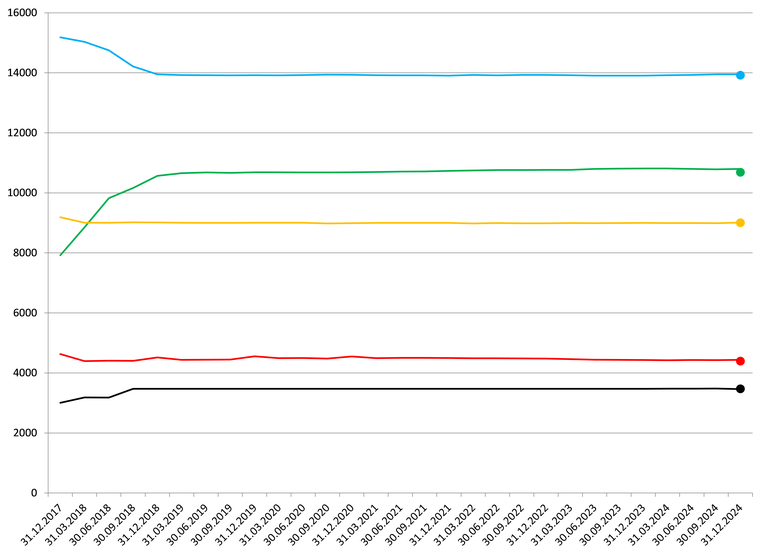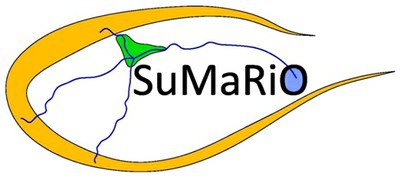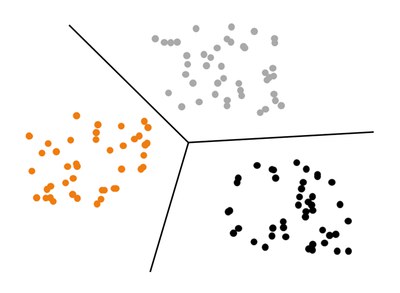Research fields of the chair
The research of the Chair of Statistics, in particular Risk Management, deals with the following topics:
- Cluster Analysis
- Mathematical Optimization
- Econometrics
- Quantitative Risk Management
Research Award
Euro Award 2013

Current research projects
The following research projects are currently being conducted at the chair.
Manpower Planning
In today's constantly changing demographic and social conditions, the manpower planning of large companies is subject to constant challenges. The targeted control of influencing variables in personnel planning while simultaneously taking into account the occurring causal relationships and existing legal framework is complex and at the same time an essential component of medium- to long-term planning of corporate development.
Especially the public service with its clearly defined promotion guidelines and medium-term defined requirements offers the possibility to mathematically model and optimize processes. For this we develop mathematical models and solution algorithms, which suggest medium-term transitions of the existing personnel structure into future target structures. At the same time, our methods take into account the most diverse requirements for the personnel development to be carried out and map the underlying personnel body on an individual basis in order to take into account the manifold special cases.
The resulting high-dimensional optimization problems are difficult to solve with standard methods of mathematical optimization due to their size. By using selected techniques of combinatorial and integer optimization, our methods are nevertheless able to solve realistic problem sizes and generate proposals for controlling the transition of the personnel structure.
An example of optimized personnel development into a target state:

Heterogeneity of Meta-Analyses
Many studies, especially in medical research areas, do not allow direct (significant) conclusions to be drawn due to insufficient data volumes. One way out is the combined evaluation of several studies (with identical research questions). This is done, for example, with the help of meta-analyses, which evaluate studies in combination and lead to significant, usable results. However, in this approach there are often challenges regarding too much heterogeneity due to the joint evaluation of partly very different studies.
Therefore, on the one hand, we investigate approaches to reduce the existing heterogeneity of a meta-analysis. Besides the combination of other methods of data analysis (such as end-point-oriented cluster analyses with the actual meta-analysis), we also consider different methods in the area of underlying data transformation.
At the same time, we are working on indicators for the assessment of existing heterogeneity, especially in combined methods such as end-point-oriented cluster-based meta-analysis.
Predictive Medicine: Analysis of patient-specific data in the field of schizophrenia
As part of predictive evidence-based medicine, in cooperation with our research partner we investigate patient-specific predictors for the efficacy of drugs in the field of schizophrenia using end-point-oriented cluster analyses. In addition to content issues, we analyze methodological approaches from a medical point of view to increase the quality and stability of prognosis. Our investigations focus on the development of automated methods for stable prognoses, especially in the areas of data transformation, automated variable assessment and the number of clusters used.
Comparison of classical prognosis models with methods of quadratic optimization
Popular classification methods, such as Logistic Regression or Random Forest, and more innovative approaches based on quadratic optimization show significant differences in their requirements for input data, the nature of their output and the extent of accessibility of their results. Within the framework of the research project, these differences will be systematically worked out using real and simulated data sets and quantified on the basis of suitable indicators. In particular, the question will be addressed to what extent different methods can be meaningfully combined with each other.
Finished research projects
The following research projects were recently completed at the Chair of Statistics, in particular Risk Management.
SuMaRiO

The objective of the project is to support oasis management on the Tarim River in Xinjiang Province, Northwest China, against the background of socio-economic changes and climate change. Within this framework, a decision support system (DSS) will be developed in cooperation with Prof. Dr. Kern (Chair of Knowledge Management and Business Process Design) as the main result of the project, which will enable a Sustainable Impact Assessment by the regional planning authorities. The perspectives of all relevant actors and decision makers in the field of land and water management along the Tarim River are taken into account. Based on the sustainability analysis, scenarios are set up and the semi-quantitative assessment of their impacts is carried out. In the implementation phase, the Chinese partners will be extensively trained in the use of the tools developed.
Clustering models and algorithms for land consolidation
In many rural areas, a small number of farmers maintain a large number of small plots scattered over a wide area. This results in high travel costs and unprofitable use of the heavy machinery required. This could be remedied by land consolidation, which often leads to undesirable side effects. We develop mathematical models and algorithms for land consolidation that do not use the results of a classical land consolidation process.
The central idea of our methods is to preserve the structure of the plots in the region. Some of these plots are fixed by the farmers and the rest are reassigned combinatorially according to specific objective functions. During this process, each farmer will receive a series of parcels approximately equal to the original total size and value of the parcels. Since the plots differ in size and creditworthiness, we get a difficult clustering problem under constraints: The decision as to whether there is a different distribution of the plots so that these constraints are met represents an NP-complete problem.
Using combinatorial optimization methods, we obtain demonstrably good and efficient approximation algorithms. Within the framework of this project two goals are pursued: On the one hand the continuous improvement of the mathematical models, which represent the real problems of land consolidation, on the other hand the development of improved algorithms for these models.

Mobility Management: Fleet optimisation under economic and ecological aspects
Since environmental considerations are increasingly coming to the fore in politics and thus also in companies and municipalities, mobility behaviour must also be adapted to this new perspective. The aim of this project is an ex post analysis and optimisation of vehicle fleets on the basis of journeys carried out in the past. Now not only economic, but also ecological aspects are to be considered and directly incorporated into the optimisation. In addition, the resulting model should be compatible with various cost structures and mobility types in order to be generally applicable and adaptable.
Risk Management in Supply Chains
The security of production and supply chains is becoming increasingly important in our highly interconnected world. In order to investigate the susceptibility of supply chains to risks such as natural disasters and to minimize the resulting failures, a new model of a supply chain network is being developed. This model will be analysed theoretically and its use in the construction of optimal production and supply chains will be investigated in practice.

Optimum degree of outsourcing for quasi-monopolies in public procurement
The focus is on the outsourcing of services from the public sector to the private sector. Our model compares the possible price advantage with the transaction costs. The project focuses on measuring the course of transaction costs and quantitatively determining the (maximum possible) level of these costs. For this purpose, the risk perception of the decision-makers is measured at different degrees of spin-off. Since the services can be very specific, it can come to the situation that exactly one buyer meets exactly one supplier. For this bilateral monopoly, it is necessary to determine determinants that make it possible to determine the equilibrium quantity and price. In addition, the model is used to give recommendations for action on how to structure the cooperation, depending on the specificity, the degree of outsourcing and the course of transaction costs.